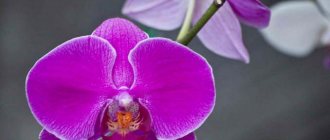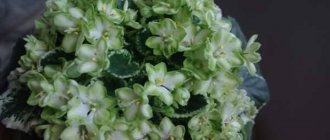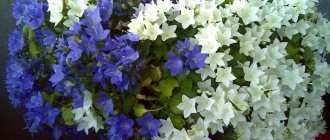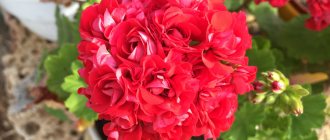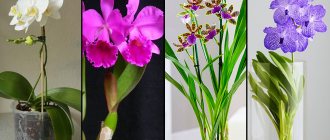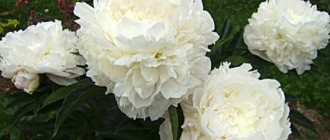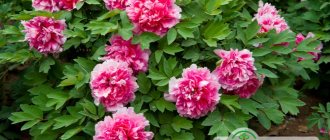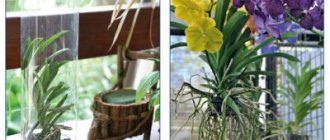Plants » Flowers
0
366
Article rating
Kira Stoletova
Clematis Tangut (lat. Clematis orientalis var. tangutica) is a typical representative of Asian flora. It grows in the forests of Mongolia and China in the form of small bushes, rarely exceeding 30 cm in height. Later, breeders developed several types of flowers. The most famous of them is the variety under the telling name “Radar of Love”.
Clematis Tangut
Description of the variety
The oval-shaped leaves are attached to the stems using long, curved cuttings. They are an unusual emerald color that changes with the seasons. They are located rarely, in pairs.
The vines are thin, herbaceous, their bark remains tender even on old bushes, it does not become woody.
The flowers of Tangut clematis (clematis) are yellow-orange drooping bells or Chinese lanterns. They cover the vine abundantly and look contrasting against the background of green foliage.
They bloom only on shoots that have grown again after winter. Each bud has 4 petals that never fully open. The diameter of the flowers is 3-4 cm, up to 100 of them are formed on each vine.
The flowering period is from May to October. Sometimes it stops, but then it starts again. After the buds wither, decorative seed pods remain in their place. They are often used in creating floral arrangements.
Varieties
Tangut clematis is a species that combines several different artificially bred varieties. Let's look at the most famous ones.
Clematis Tangut love radar
Love Radar - has small, bright yellow, bell-shaped flowers. The height of the bush is up to 3 meters.
Anita - flowers are white, numerous, bloom twice a year - in June and September. The vines reach a height of 3-3.5 meters.
Aureolin - yellow bells bloom on a small bush. Their diameter is up to 3 cm, each vine has up to 120 buds.
Golden Waterfall - the flowers are bright yellow, their diameter is 6 cm. This is the largest-flowered variety of Tangut clematis. The height of the bush is up to 4 meters.
Cotton candy - the flowers are pale, lilac-gray, with thin hanging petals, and from a distance they resemble a fluffy ball.
Bill MacKenzie is the tallest variety. It has yellow flowers that bloom from May to September. The height of the bush can reach 5-6 meters. Often used in the design of gazebos and decorating the facades of houses.
Grace is a medium-growing, but very decorative variety. The flowers are beige immediately after blooming, then acquire a pinkish tint. The 3.5 meter tall bush looks beautiful and unusual.
Lambton Park - the bush reaches 4 meters. The flowers are large, up to 5 cm in diameter. Not demanding on lighting, can grow in the shade. The flowers are brown-yellow, small, half-open.
Last Dance. The variety blooms long and profusely with yellow-orange bells. It quickly entwines any support, the height of the bush is up to 4 meters.
It is possible to grow each of the varieties from seeds in 1-2 years. The plant generally reproduces easily, quickly beginning to bloom. To design a site, you need to think in advance about the purposes for which the vine will be used. The variety is selected based on the height of the bush.
Video
You can see what Tangut clematis looks like and learn about the peculiarities of its cultivation in different regions from the following videos:
Graduated from MGRI named after. Ordzhonikidze. My main specialty is a mining geophysicist, which means a person with an analytical mind and varied interests. I have my own house in the village (accordingly, I have experience in vegetable gardening, horticulture, mushroom growing, as well as fiddling with domestic animals and poultry). Freelancer, a perfectionist and a “borer” regarding his duties. Handmade lover, creator of exclusive jewelry made from stones and beads. A passionate admirer of the written word and a reverent observer of everything that lives and breathes.
Found a mistake? Select the text with the mouse and click:
Landing Features
Planted both in early spring and throughout autumn. The species is winter-hardy and easily tolerates frosts down to -35 0C. When planting in spring, you need to try to do it before the leaves begin to bloom on the seedling. During the period of swelling of the buds, it is easier for the plant to take root. Such a clematis will bloom a year later.
Clematis Tangut planting and care photo:
Autumn planting is more reliable and ensures early flowering of the bush.
It is allowed to transfer seedlings into open ground from September to the end of October, depending on the climate zone. The main thing is that from planting to frost there is at least 3 weeks for rooting. Then the plant will take root and may bloom next year.
Selecting a location
The place should be well lit, but the bush should not be in direct sun all day. Some partial shade for at least 4-5 hours is ideal.
It is better to plant the plant near walls, which will simultaneously serve as support and protection from the scorching sun and wind. The main thing is to retreat 50-60 cm when planting so that the roots develop normally.
The distance between bushes should not be less than 1 meter.
When selecting a planting site, you need to take into account the depth of groundwater. If they are close to the surface, it is better to look for another area. If there is no choice, then you will have to make a deep hole with multi-layer drainage to prevent rotting of the roots.
Preparation of planting material
The seedlings must be healthy, otherwise it will not be possible to grow a full-fledged flowering bush. The root system should consist of at least three roots 10-15 cm long.
When purchasing, it is advisable to check the roots by lightly running your fingernail along one of them. If white pulp is visible inside, the root is healthy.
The shoots are also checked for the presence of growths, spots, fluffy plaque, cracks and wounds - their presence indicates that the plant should not be planted on the site.
It is better to place it in a flowerpot and quarantine it indoors until the next season. At the same time, the seedling is treated with the necessary drugs (depending on the problem). The next year, healthy young clematis is planted in the garden.
Landing technology
First, prepare a hole for the bush. It is better to do this in advance - 1.5-2 months before planting. During this time, the soil will settle, acquiring the desired structure. Drainage must be poured onto the bottom. Its thickness depends on the proximity of groundwater: the closer it is, the more multilayered the drainage is.
Clematis Tangut cotton candy
It is used as:
- broken red brick;
- stones;
- clay shards;
- large expanded clay;
- gravel;
- coarse sand.
The layers are laid in exactly this order - from large to small. Then the soil is poured. Its composition looks like this:
- nutritious leaf soil (universal flower soil);
- peat;
- humus;
- compost;
- ash;
- dolomite flour (for high soil acidity).
Important! Acidic soils are not suitable; clematis does not bloom on them, gets sick and loses its leaves. The soil must be neutralized as much as possible using ash and dolomite flour. The procedure is repeated every year in the spring, otherwise the soil parameters will return to their previous values.
The seedling is transferred to the hole and the roots are straightened. Sprinkle soil on top, shaking the trunk slightly (so the soil is evenly distributed between the roots). The root collar should be 10-15 cm deep underground. The pit is watered, the soil around the bush is mulched with hay, straw, sawdust, and peat.
Specifics of cultivation
Planting and caring for Tangut clematis is not much different from the agricultural practices of other varieties of this crop. The plant prefers well-drained soils with acidity close to neutral. Organic fertilizers are usually added to the planting hole in an amount sufficient for the growth of the seedling and strengthening its root system.
Bushes that are placed in areas with high groundwater levels require special care. To protect the roots of plants from getting wet, “pillows” are placed at the bottom of the holes, consisting of several layers of drainage materials - pebbles, crushed stone, broken tiles and coarse sand. Trellis for vines must be installed simultaneously with planting, since clematis may need supports in the first summer.
Trimming group
When it comes to care, Tangut clematis is considered one of the most unpretentious. It grows successfully even on “skinny” soils, hardly gets sick, and easily tolerates dry periods and fairly severe frosts. The plant is especially convenient because in most climate zones it can do without pruning in the fall and winter shelters. The bushes bloom on the shoots of the current year. That is why this clematis belongs to the third pruning group , but such a procedure is not as fundamental for it as for its large-flowered “brothers”. Many gardeners limit themselves exclusively to regular sanitary and anti-aging pruning, which helps shape the bushes and maintain their decorative appearance.
Care
Unlike artificially bred species, Tangut clematis grows safely in nature, even in the most remote northern regions. It easily endures winter and is resistant to diseases. A plant can only be ruined by incorrectly chosen conditions and errors in care.
Clematis Tangut Chinese lanterns
Watering
Seedlings of the first year of life are watered 2-3 times a week with settled water. The ideal option is rainwater, which is better absorbed by the roots. If the summer is rainy, the watering regime changes.
An adult bush requires 25-30 liters of water per watering; a young bush needs one bucket.
It is impossible to overdry the soil - its surface roots suffer the most. Without a healthy root system, it will be impossible to achieve lush flowering of the bush.
Top dressing
Even the most fertile soils will not be able to provide the plant with all the nutrients required for long flowering and green mass growth.
In spring, nitrogen fertilizers are applied:
- Nitrate;
- Ammonia;
- Ammonium nitrate;
- Amide (urea and calcium cyanamide).
Closer to summer, phosphorus is needed. It participates in all metabolic processes and increases frost and drought resistance. Without it, sugar, starch and fat do not accumulate in the cells, without which the plant dies.
Fertilizers with high phosphorus content:
- Ammophos;
- Diammophos;
- Superphosphate;
- Precipitate;
- Phosphorite (or bone) meal.
Potassium also needs to be added in mid-summer. Its main property is to increase plant immunity and their resistance to disease. Fertilizers:
- Potassium nitrate;
- Potassium chloride;
- Calimagnesia.
At the end of summer, organic matter is added to the soil - manure or bird droppings. They should be dry, rotted, preferably 2-3 years old. The bush is later fertilized with the same manure before wintering. This is both a source of nutrition and insulation for the plant.
Loosening and mulching
The roots of clematis are located close to the surface. They need to breathe, so the soil in the tree trunk circle is regularly loosened. The main thing in this matter is to be careful not to damage the delicate roots. The second important procedure is mulching (to protect the root system from the sun and drying out).
Not only hay, straw, pine needles or sawdust are used as mulch. Low-growing annuals are also planted directly under the bushes. They will prevent weeds from sprouting and will also protect from the scorching sun.
Herbs such as calendula and marigold serve to repel harmful insects. They should not be weeded out in the fall, leaving them on the soil as useful humus.
Trimming (trimming group)
Tangut clematis pruning group is the third. This means that in the fall it is necessary to remove all the old shoots down to the lower three or four buds - in this case, you can really count on lush flowering next year.
Clematis Tangut seeds
You can prune bushes not only in autumn, but also in early spring, but the first option is preferable.
During the summer, the bush also needs sanitary pruning - cutting off withered, weakened, broken shoots. This prevents the bush from thickening and allows the leaves and buds to receive more light and fresh air. Timely removal of diseased shoots will save the entire bush from infection and even death.
Shelter for the winter
Despite the resistance of the Tangut species to cold weather, it is still recommended to cover it. First of all, young bushes protect from frost. They are covered with peat, spruce branches or dry leaves. Non-woven material and film are laid on top.
You can cover the plant with a small wooden box and then cover it with film. An air layer is formed inside, which, if there is a thick layer of snow above, will act as a greenhouse. The main thing is to remove this cover in time in the spring so as not to overcook the plant.
Gallery: clematis (25 photos)
Variety Love Locator
Today, Tangut clematis has a large number of varieties.
The most popular variety is called Love Locator. It is grown with great success for decoration and landscape design. The stems reach a length of up to 3 m. Yellow flowers grow on them, shaped like small bells. The love locator blooms for a long time, up to four months, after which the plant produces fruits.
Clematis love locator is quite easy to plant and grow at home even for inexperienced plant lovers. Planting clematis with seeds is the most common. There are two ways to do this: with and without stratification.
On a note! During stratification, certain artificial conditions are created for seeds. These conditions imitate natural ones. Under their influence, seeds germinate better and germinate faster.
Growing from seeds - method one
The first method, using stratification, looks like this:
- The seeds are placed in the freezer for 30 minutes.
- Remove from the chamber and keep in a dry place for two hours at room temperature.
- They are placed in the chamber again for half an hour and taken out again. The process is repeated three times.
- The planting material is laid out on a plate and treated with a stimulant (superphosphate or mineral fertilizers).
- Then the remaining stimulant is washed off from the seeds and dried.
- The seeds are laid out on a plate, covered with plastic wrap, and placed in a dark place.
- They are kept in this form for three days.
- After this time, the film is moved to the side to allow air access to the seeds.
- After 10–14 days, the seeds produce the first shoots, which are transplanted into pots.
Method two
Growing clematis from seeds at home without stratification involves the following nuances.
- In order to grow Love Locator at home from seeds, they must be sown in special boxes with substrate or nutrient soil.
- Seeds are planted at the end of February and grown under glass, maintaining a constant temperature.
- Constant watering and ventilation are required.
- A month after planting, the first shoots appear, which also require care and maintenance of the required temperature and lighting.
- Clematis is replanted in early June; before this, the soil in the pot needs to be prepared. To do this, you need to mix the following ingredients: soil, compost, peat, sand.
- In order to stimulate growth, mineral fertilizers or superphosphate are added to the prepared mixture.
- Then the pot is filled with the mixture and the seedling is planted.
- The root neck should be at a depth of no more than 10 cm.
- After this, the bush is watered abundantly.
- It should be noted that Love Locator, like other types and varieties of clematis, loves sunny places. However, during the day, when the sun is especially hot, the plant needs partial shade.
Caring for the Love Locator
Caring for this clematis contains a number of mandatory points:
- After the first pair of leaves appear on the seedlings, they are planted in different pots.
- The grown shoots of the plant must be systematically pinched. Thanks to this, clematis strengthens its root system.
- The soil in which the bush grows must be periodically fertilized with organic humus.
- Add fertilizing to the soil weekly: ash, mullein and superphosphates.
- The grown branches need to be tied to supports to strengthen the trunks.
- It is necessary to promptly remove weak and diseased shoots and damaged parts, sprinkling the remaining parts with coal.
- The plant is moisture-loving, so it requires regular watering. During the period of active development and flowering, clematis is watered twice a week; one bush needs about 30 liters of water.
On a note! Although clematis is an unpretentious plant, it still requires careful care.
Reproduction
Clematis Tangut, unlike the others, is most often propagated by seeds. Their high percentage of germination and rapid growth of green mass allows you to get a full-fledged plant in 1-2 years. Clematis is also propagated vegetatively.
Seeds
Before sowing, the seeds are usually soaked for a day in warm rainwater. Then they are placed in a substrate: turf soil, coarse sand, crushed chalk. They are placed at a distance of 3-4 cm from each other, so that later you do not immediately resort to picking.
The container should be placed in a dark, cool place with a temperature of +13-15°C. This is a prerequisite for the germination of clematis seeds. Shoots appear after 3-4 weeks, after which the container is immediately transferred to light and begins to warm up. Water the seedlings with a spray bottle, not at the root.
Clematis grows very quickly. When 7-8 leaves appear, the seedling can be transferred to a greenhouse on the site. This is how the young plant will spend the first year of its life, after which it will “move” into open ground to a permanent place. When propagated by seed, the Tangut species blooms already in the 2-3rd year from planting.
By layering
In summer, the shoot is bent to the ground and fixed with a stone, sprinkled with earth on top, leaving the top on the surface. Water the cuttings regularly until they take root completely. This usually happens after 1-2 months, but the shoot cannot be separated immediately. He must gain strength to be able to feed on his own.
For the first winter, the cuttings are left together with the mother bush. Then in the spring, as soon as the shoots almost begin to swell, the cuttings are separated and planted in a new place. It immediately begins to grow and blooms the very next year, retaining all its varietal properties.
Cuttings
You can prepare material for cuttings in the fall, but it is better to do this in early spring. From one young shoot several full-fledged cuttings with 3-4 buds are obtained at once. They are rooted in a nutrient substrate. This usually takes 4-5 weeks. Then the seedlings are transferred to a greenhouse or kept at home until next year.
Dividing the bush
Dividing a bush is a way not only to propagate it, but also to rejuvenate it. It is subject to old clematis from 6 years old, which are dug up and cut into several parts. The sections are treated with fungicides and filled with warm wax to prevent infection.
Each individual bush is planted on a plot at a distance of 70 cm from each other. The old bush with the main root is returned to its original place. The soil underneath is updated by adding nutritious humus, leaf turf and compost. The bush will bloom profusely in it for many years to come.
Clematis Manchurian
The homeland of Manchurian clematis is the Far East of Russia and the eastern part of China. This is an unusually beautiful plant. This species is considered one of the rare ones. Clematis Manchurian is an ideal plant for landscaping and decorating not only a personal plot, but also a house or apartment.
- Stems-lianas. This is a perennial herbaceous plant belonging to the types of ornamental vines. It is used for vertical gardening. The height of the herbaceous vine reaches from 1.5 to 3 m. It has very branched stems that cling to surrounding plants, buildings and other objects.
- Leaves. The leaves have a complex structure, each consisting of 3-8 or smaller leaflets. The stems and leaves of this type of clematis have a burning taste and a pungent odor when broken or torn. Its pungency can cause irritation to human skin.
- Flowers. Clematis Manchurian flowers have a pleasant aroma, which opens especially well when exposed to sunlight. They appear in late June - early July; on one shoot they can grow from 200 to 500 white flowers with four oblong petals.
On a note! The Manchurian species is ideally suited for propagation by seeds in the Russian temperate climate.
Plant propagation
When propagating clematis Manchurian seeds, their size should be taken into account, since the timing of planting directly depends on it. Clematis has medium-sized seeds, so the best time to plant is early March. In this case, the first shoots will appear in 3-6 months.
Before planting clematis Manchurian, you need to take the following steps:
- It is best to use seeds from the current year, which increases the likelihood of more seedlings appearing.
- You can stratify the seeds before planting, but this is not necessary for this species.
- The seeds are soaked in water for a week for better germination in the future.
- Prepare a soil mixture consisting of sand, peat and soil in equal proportions.
- The seeds are planted on the surface of the soil mixture and sprinkled with a layer of sand on top.
- The ideal temperature for germinating seeds is from +25 to +28°C, they should be covered with film or glass.
- In the future, the soil must be watered and moistened so that the seeds are not washed away. For this, a tray irrigation method is used.
The appearance of the first shoots
After the first shoots appear, the pots are moved to a sunny place, but avoid direct sunlight. Or they provide the sprouts with diffused lighting using fluorescent lamps.
- Picking into separate pots is done when the first pair of true leaves appears.
- To stimulate branching, seedlings are pinched.
- After 2-3 years, the root system of the seedlings grows up to 15 centimeters, therefore, the plant is ready to be transplanted into a large pot.
- The pot must be large (at least 25 liters).
- To form plant vines, supports are required.
- Clematis is replanted every three to four years.
Caring for this variety before winter
When caring for clematis Manchurian before winter, you need to remember:
- The method of caring for it also depends on the age of the plant. When you care for young clematis, you need to cut off all its buds that appear on it. This is done so that all the plant’s energy is spent not on the growth of flowers, but on the formation of stems and root systems.
- Clematis Manchurian does not like an abundance of water, so it is necessary to provide it with even watering. Young plants are watered once every five days, and adults - once every ten days.
- In the fall, pruning is done and the plant is removed to the basement or other cool place. Plant varieties that bloom on the current year's shoots are pruned to a height of one or two buds from the ground, and varieties that bloom on last year's shoots are pruned to a height of 50 to 70 cm.
Further care
With the onset of cold weather, the plant is transferred to the balcony for a period of rest.
- In mid-February, the seedlings are brought back into the room and provided with good lighting using lamps. The seedling must be pruned regularly, keeping it within the designated boundaries.
- The plant will bloom in early spring. The first flowers look pale and dull, but as daylight increases they acquire a natural, rich and bright color.
- In the summer, it is recommended to keep the pot with the plant on the balcony or on the windowsill, allowing it to breathe and receive sunlight.
By following all the recommendations on how to grow clematis from seeds, you can get unusually beautiful plants of various types at home. They will delight you for many years.
Diseases and pests
Clematis are resistant to diseases, but under unfavorable conditions they can be affected by various misfortunes. Some of them are treated with special drugs, but for some there is no salvation. The main thing is to regularly inspect the plant in order to notice the problem in time.
Clematis Tangut description
Powdery mildew
This is a fungal disease that appears as a white coating on leaves and branches. Treated by spraying with fungicides: Bayleton, Quadris, Skor, Topaz, Tilt. Treatment is carried out twice with an interval of 2-3 weeks.
Gray rot
The sources are canidia - fungi that live in the soil. With increased humidity and lack of sunlight, they attack the plant from below, from the trunk. It will smooth out the disease like a gray fluffy coating. It is treated with the following drugs: Fitosporin-M, Gamair, Alirin-B, Fundazol.
Rust
A diseased plant develops red spots on the leaves, which expand and “grow.” It has been proven that juniper can be the main source of infection. Rust is treated with sulfur-based preparations, Bordeaux mixture or urea.
Wilt
Wilt or wilt of clematis is caused by fungi of the genus Phomopsis. The tops of the shoots wither and die, then all the shoots die. The main thing is to notice the disease at an early stage, remove all affected areas, treat the bush with drugs: Fundazol, copper sulfate, potassium permanganate.
Aphid
These pests are easy to spot in the leaf axils and on the buds. They suck the juices out of the plant, preventing its normal growth. The best remedy for fighting aphids is tar soap and Biotlin. The plant is also sprayed with a kerosene solution or an infusion of onion peels.
Root nematode
These are microscopic worms that reproduce in the roots of the plant. Their numerous colonies are capable of destroying even an adult bush. The main problem is late detection of pests. Usually, symptoms appear when it is impossible to help clematis. It has to be destroyed, and the ground beneath it must be thoroughly disinfected several times.
Use in landscape design
Tangut clematis is used to decorate gazebos, arches and facades. The support for the bush should be as strong as possible, so walls and metal arches and gazebo posts are preferable to plastic mesh. The plant grows quickly, covering any surface in a few weeks.
Clematis with bell flowers looks good in joint compositions with roses, hydrangeas, and decorative grape varieties with multi-colored leaves. The combination of several varieties gives an unusual effect and is used by many gardeners.
Reviews
This type of clematis is common in different latitudes and is loved for its unpretentiousness, immunity stability and ease of reproduction. People note its ability to withstand the coldest winters. Many positive reviews also concern the decorative nature of the species and the unusual nature of its colors.
The Tangut species is rightfully considered one of the best. The plant has many positive properties, and it does not require complex care. Lush flowering even after frosty winters and resistance to disease make the species very popular among gardeners in different countries.
